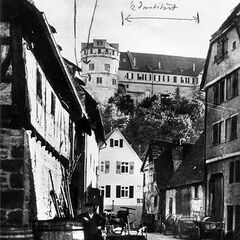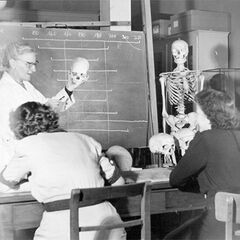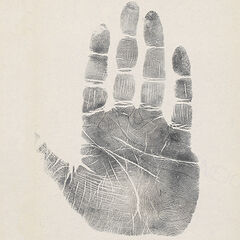Hohentübingen Castle: Science and Crime during National Socialism
Station im Stadtrundgang: History Path to National Socialism
Hohentübingen Castle housed various university departments which supported Nazi ideology and the regime's policies of racism and conquest. Some scholars were even directly involved in Nazi crimes.
German Studies scholar Gustav Bebermeyer (1890-1975) was a member of the Nationalsozialistische Deutsche Arbeiterpartei (National Socialist German Workers' Party, NSDAP) and became head of the newly founded Institut für Deutsche Volkskunde (Institute for German Ethnology) in 1933. At the same time, he organized the “Gleichschaltung“ (forced coordination) of the university's committees.
Another new foundation was the Rassenkundliches Institut (Institute for Racial Studies). Its director, Wilhelm Gieseler (1900-1976), was a member of both the NSDAP and the Schutzstaffel ("Security Squadron", SS). The Institute prepared surveys classifying individuals as "Aryans", "Jews", "mixed-blood Jews", "Gypsies", or "mixed-blood Gypsies". This opened the avenue to deprive these persons of their rights and to persecute them. In 1943, faculty member Hans Fleischhacker (1912-1992) selected, by order of the SS, Jewish inmates from the concentration and extermination camp of Auschwitz, 86 of which were specifically murdered for a skeleton collection of the Reichsuniversität (Reich University of) Straßburg.
The Institute für Völkerkunde, für Geographie, and für Ur- und Frühgeschichte (Institutes for Ethnology, for Geography, and for Pre- and Early History), all founded before 1933 and also situated in the castle, also aligned their research to some extent along the lines of race studies and German territorial claims.
Image 1
Undated postcard showing a view of the northeastern tower of Hohentübingen Castle. The Rassenkundliches Institut (Institute for Racial Studies), founded in 1934, was housed in this tower and the adjacent wings. The handwriting is by Wilhelm Gieseler, the institute's director. Photo: Cultural Office, University City of Tübingen
Image 2
Sophie Ehrhardt (1902-1990), pictured here teaching in 1951. She worked in the Rassenkundliches Institut (Institute for Racial Studies), later renamed Anthropologisches Institut (Institute for Anthropology), from 1942 to 1968. Before this, she was involved in registering Germany's Sinti and Roma in Berlin. She used parts of this register until the 1980s for "Zigeunerforschung" ("Gypsy research"). Photo: City Archives Tübingen
Image 3
One of 309 hand prints of Jews from Litzmannstadt (Łódź) used by Tübingen Racial Studies scholar Hans Fleischhacker in his 1943 habilitation. His thesis was that membership of the "Jewish race" could be proved through hand prints. Image: Tübingen Institute for Ethics and History of Medicine




